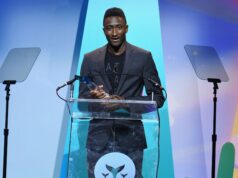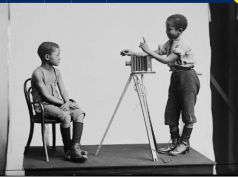The overall concept of the 100 began in New York in 1963 when a group of concerned African American men began to meet to explore ways of improving conditions in their community. The group eventually adopted the name, “100 Black Men, Inc.” as a sign of solidarity.
These men envisioned an organization that would implement programs designed to improve the quality of life for African Americans and other minorities. They also wished to ensure the future of their communities by aiming an intense number of resources toward youth development. These members were successful black men from various walks of life. These visionaries were business and industry leaders such as David Dinkins, Robert Mangum, Dr. William Hayling, Nathaniel Goldston III, Livingston Wingate, Andrew Hatcher, and Jackie Robinson.
Dr. William Hayling, a member of the NY organization, had relocated to Newark, NJ and sought to replicate the 100’s impact in that area. In 1976 Dr. Hayling formed the 100 Black Men of New Jersey. A movement had been born. Men across the country began to form 100 Black Men organizations to leverage their collective talents and resources. Chapters were formed in Los Angeles, Indianapolis, St. Louis, Pittsburgh, Atlanta, San Francisco/Oakland Bay Area, Nassau/Suffolk, Alton, and Sacramento.
On September 21, 1983, a three-hour meeting was held at the Washington Hilton Hotel in Washington, D.C., among representatives from the Los Angeles, New York, New Jersey, and St. Louis chapters. This meeting was to evaluate the feasibility of establishing a National Organization for 100 Black Men. This meeting was held during the annual weekend meeting of the Congressional Black Caucus.
Representative of St. Louis, Pittsburgh, Atlanta, the San Francisco/Oakland Bay Area, Nassau/Suffolk and Sacramento met for a second time in Las Vegas, May 11-13, 1984, at the Las Vegas Hilton Hotel. The men engaged in extensive discussions about the most effective structure to support the growth and governance of 100 Black Men chapters.
The third meeting was held May 16-18, 1986 at the Flamingo Hilton Hotel in Las Vegas. At this meeting it was agreed that the best model for a newly-formed national organization was a federation governance model. This model leveraged human and financial resources, and supported chapter growth while preserving chapter autonomy. It was also voted that a National Steering Committee would include the Presidents of each chapter, along with two members from each chapter.
A final meeting was held on October 2, 1986 at the L’Enfant Plaza Hotel in Washington. Chapters represented were: Los Angeles, St. Louis, Indianapolis, Atlanta and New Jersey. The chapters decided that the name of the organization would be: “100 Black Men of America, Inc.”
The following individuals were elected as officers:
Dr. William Hayling (Los Angeles) President Moses Gray (Indianapolis) Secretary Oliver Lofton, Esq. (New Jersey) Vice-President Jesse C. Swanigan (St. Louis) Treasurer On May 27, 1987, in Atlanta, Georgia, this newly formed organization introduced itself to the nation during its first national conference. Noted speakers included the late Alex P. Haley and the late Honorable Maynard H. Jackson.
In 1989, Nathaniel R. Goldston III became the organization’s second National President and grew the organization to 43 chapters. Mr. Goldston used his business acumen and resources to expand the number of chapters and enhancing the organization’s infrastructure. Under Mr. Goldston, the organization acquired its first national office and its first Executive Director. Along with Mr. Goldston, Warren Valdrey (Vice President), T.B. Boyd III (Treasurer) and Moses Gray (Secretary) served as elected officers.
In 1994, Thomas W. Dortch Jr. was elected the third National President. That year, he spearheaded an aggressive plan entitled Four For The Future™. Since that time, the organization has strategically channeled its resources toward programs that support these important areas: Mentoring, Education, Health & Wellness, and Economic Development. The 100 has identified these areas as being critical to the future of African Americans.
Along with Mr. Dortch, LeRoy G. Walker, Jr. (Vice President), William L. Wimberly (Vice President), Hon. Roosevelt F. Dorn (Vice President), Lonnie J. Carr (Treasurer), and Albert E. Dotson, Jr. (Secretary). In 1997, under Mr. Dortch’s leadership the organization expanded internationally with the chartering of the Birmingham, England chapter. Additional international chapters and interest groups followed including: Nassau Bahamas, Goree Island, Senegal, Kingston, Jamaica, U.S. Virgin Islands, and London, England. It was also in 1997 that the organization purchased its World Headquarters building on historic Auburn Avenue in Atlanta, Georgia. Also, during Mr. Dortch’s tenure, the Collegiate 100 was formed to focus the next generation on mentoring.
In 2004, Albert E. Dotson, Jr., Esq. was elected the fourth President/Chairman of the Board and during his inaugural address he recognized the contributions of his predecessors. Dr. Hayling was acknowledged for bringing the various 100 Black Men organizations under the single banner of 100 Black Men of America. Mr. Goldston was recognized for his personal investment of talent and resources that grew the number of chapters focused on the 100’s mission. Mr. Dortch was acknowledged for expanding the organization’s resources and building capacity for the 100 to carry out its mission. Chairman Dotson referred to their contributions as the Hayling Harvest, the Goldston Gain and the Dortch Dividend.
The other newly elected officers in 2004 were Curley M. Dossman, Jr. (Vice Chair Operations), Frank Hayes (Vice Chair Finance), Dr. Joshua W. Murfree, Jr. (Vice Chair Programs), John S. Kendall (Vice Chair of Operations) and Anthony B. O’Neill (Secretary). Since 2004, Chairman Dotson has focused the organization on leadership and delivering impactful and innovative programs in each of the Four For The Future areas.
During Dotson’s tenure the 100 launched the Leadership Development Institute (LDI) to provide a vehicle through which members of the 100 could fine tune and enhance their leadership skills. The 100 also created their Community Empowerment Project (CEP) which ensures that the city where the 100 convenes its Annual conference receives a social and societal impact that is sustainable by the community.
From 2006 to 2009, the 100 helped launch the National Cares Mentoring Movement (formerly Essence Cares) to mobilize millions of able African Americans to take the lead in fulfilling our society’s spiritual and social responsibility to our children. The 100 expanded its focus on advocacy for responsible public policy, including sponsoring the Internationally broadcasted debate on urban issues among Presidential candidates Senator Barack H. Obama, Senator Hillary R. Clinton and Senator John Edwards. The 100 has consistently increased its resources to deliver relevant new programs and enhance signature programs. The organization is moving their mission and strategic direction forward as it implements Mentoring the 100 Way Across a Lifetime sm.
Today the organization has grown to over 116 chapters with more than 10,000 members who continue to strive to improve the quality of life in our communities and enhance the educational and economic opportunities for African Americans. 100 Black Men of America, Inc. has more than 100,000 youth participants annually in its mentoring and youth development programs. With a mission to improve the quality of life and enhance educational opportunities for African Americans, members of the 100 continue to serve as a strong force in the world by overcoming the cultural and financial obstacles that have limited the achievements of some African Americans, particularly young African American males. Members of the 100 have made outstanding progress, proving that Blacks can, and do, excel as corporate leaders, community leaders and as independent business owners.
Mission
The mission of the 100 Black Men of America, Inc. is to improve the quality of life within our communities and enhance educational and economic opportunities for all African Americans.
Vision
100 Black Men of America, Inc. seeks to serve as a beacon of leadership by utilizing our diverse talents to create environments where our children are motivated to achieve, and to empower our people to become self-sufficient shareholders in the economic and social fabric of the communities we serve.
Values
100 Black Men of America, Inc. is committed to the intellectual development of youth and the economic empowerment of the African American community based on the following precepts: respect for family, spirituality, justice, and integrity.










